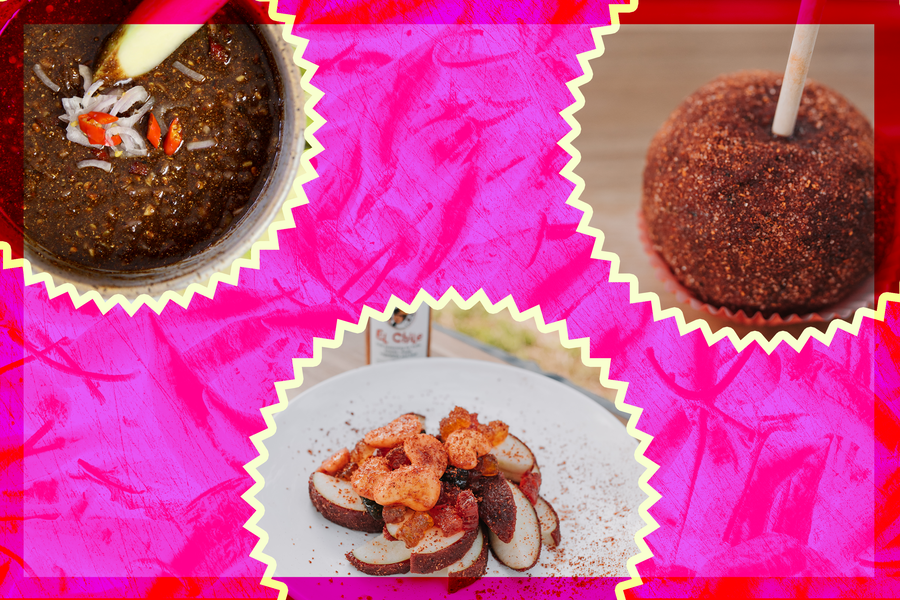
Fruit is usually associated with sweets: chocolate-dipped strawberries, fruit salads with creamy yogurt dressings, glazed fruit tarts ladled with silky custard. All of these treats are fine as they are, but there’s a missed opportunity across the U.S. in the ways that fruit can be enjoyed. Fruit is, undoubtedly, also delicious with more savory components.
Take a classic, for example: peanut butter and jelly. The salt and nuttiness of peanut butter somehow perfectly complements syrupy fruit jams. Or the perfection of a fruity margarita rimmed with salt and Tajin.
“Growing up, my preference has always been sour fruits or mango that’s unripened. I remember [going] to a park as a kid where we would grab unripened crab apples and eat it with unfiltered fish sauce dip and jeow mak muang dip,” remembers Saengthong Douangdara, who runs the Lao food blog, Saeng’s Kitchen. “It’s always been the one thing that my parents loved when it comes to fruits. We didn’t really eat the sweet fruits unless we went to a western restaurant.”
Jeow mak muang, or green mango dip, is explosively flavorful, thanks to shrimp paste, fish sauce, and bird’s eye chili that provides lip-smacking heat. To balance out the pungency, sugar is added, as well as toasted rice powder and shallots for texture.
Similar flavor profiles can be found throughout Southeast Asia. There’s rojak, a fruit salad popular in Malaysia, Singapore, and Indonesia that combines the flavors of hoisin sauce, shrimp paste, palm sugar, and chilies with pineapple, jicama, peanuts, and cucumbers. It will beat out any vanilla yogurt-based fruit salad.
Nuoc mam duong is Vietnam’s answer to salty fruit dips, combining fish sauce, sugar, and freshly sliced Thai chiles for a sweet and spicy glaze to be consumed with unripened mangoes and green guavas. Thailand’s nam pla wan is similar to jeow mak muang, but may also include dried shrimp or toasted shallots.
“Jeow mak muang was my candy growing up,” Douangdara grins. “It’s this pungent yet sweet and spicy, thick, syrupy dip that just goes well with all unripe fruit, particularly mango as it’s named after. But even for me, I’ve found that when I don’t have unripened mango, I usually get a granny apple.”
For those who have never had it, the closest thing Douangdara can compare it to is chamoy—a jewel red savory, tangy, and sweet dip popular in Mexico and in communities throughout the U.S.
“It’s so interesting because chamoy came to Mexico, but its roots are from Chinese culture,” says Sara Torres, the self-proclaimed Chamoy Queen who runs a small business of the same name cooking up her own fresh batches of chamoy.
Torres was inspired to start her business because, during her pregnancy, she couldn’t stop eating chamoy—but found that store-bought versions continuously gave her heartburn. Making it from scratch seemed like a better decision for her and her baby, so she began boiling together tamarind, hibiscus, apricots, and dried chilies to prepare her sauce. “I was always craving the chamoy apple—that was like my number one thing. So I started making my own chamoy paste to put on my apples.” Chamoy Queen is the nickname her husband gave her after witnessing her neverending cravings.
Her homemade batches were such a hit for her and her family that when her husband was out of work in 2019 due to an injury, she conjured up a business plan to begin selling chamoy-dipped apples. It was a medium still familiar to people who had never tried chamoy—like a candy apple—but submerged in the sticky and savory glaze of chamoy instead.
What began as a small drop-off business serving the greater Long Beach area of Southern California has spun into a thriving online business. Torres began combining her chamoy with other sweet treats, like candy. She now has 22,000 followers on Instagram and counting—a far cry from the lowered expectations she initially had when starting her business in early 2020, right before the beginning of the pandemic.
“We’ve had people from different cultures try it, and I was amazed to see that everybody likes it,” Torres beams. Orders have shipped out across the country, from Alaska to Tennessee to Florida, and support from her community has kept her small business afloat during an otherwise difficult time.
Torres is excited to spread the gospel: “It just pairs really well with fruit.”
Saeng’s Kitchen Recipe for Jeow Mak Muang/Green Mango Dip
Roast:
- 1 cup dried bird eye chili
- 1 cup sticky rice
For the dip:
- 1 teaspoon shrimp paste
- 1 Tablespoon fish sauce
- 1 Tablespoon ground bird eye chili
- 2 Tablespoons roasted rice powder
- 2 Tablespoons sugar
- 1 teaspoon msg
- 4 Tablespoons padaek, unfiltered fish sauce
- 4 fresh bird eye chili peppers
- 1 small shallot, diced
Directions:
1.Wash mango and sit in ice cold water.
2. Roast chili peppers until slightly darkened for 3 minutes.
3. Roast rice on medium high until dark for 11 minutes.
4. Let the rice and pepper cool then smash separately.
5. In a bowl, add the shrimp paste and fish sauce then mix.
6. Add the ground chili pepper, roasted sticky rice powder, sugar, msg, padaek, fresh bird eye, and shallots.
"fruit" - Google News
August 31, 2021 at 10:01PM
https://ift.tt/3DscZTb
Fruit Just Tastes Better With These Savory and Spicy Dips - Thrillist
"fruit" - Google News
https://ift.tt/2pWUrc9
https://ift.tt/3aVawBg
Bagikan Berita Ini














0 Response to "Fruit Just Tastes Better With These Savory and Spicy Dips - Thrillist"
Post a Comment